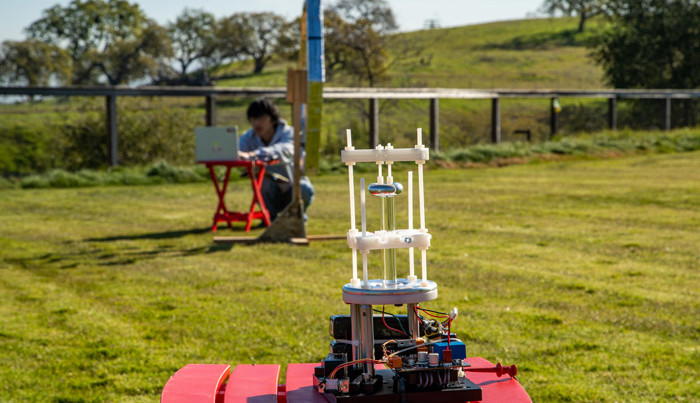VLF using a 4 inch antenna?
April 22, 2019
on
on

At Stanford University's SLAC National Accelerator Laboratory, a novel, relatively compact antenna for extreme long-wave radio communication has been developed. The frequencies used enable the transmission of signals through water.
The compact design of the antenna will allow VLF shirtpocket-sized radios to be developed. This is quite a technical marvel given that extremely low frequency VLF radio signals have a wavelength extending up to hundreds of kilometers (in the kHz range). Signals transmitted in this frequency band can penetrate water and also solid rock.
Long waves but short antennae
Generating of VLF signals is not technically demanding but the main problem hampering the development of long-wave radios it the length of antenna required to resonate at such long wavelengths. The novel VLF antenna developed at the National Accelerator Lab consists of a 4 inch long lithium niobate crystal which is a material with piezo-electric properties. This compact antenna will allow relatively small radios to be developed which could be carried by underground workers and also used by rescue teams to establish a communication link in the event of an emergency. Military applications of the technology are also likely. The radio developed by the researchers is said to be 100 times more effective than previously used compact VLF devices and can transmit data at a higher data rate.

The VLF antenna. Image: slac.stanford.edu
Shannon's Law tells us that the maximum attainable error-free data speed, in bits per second (bps), is a function of the signal-to-noise ratio and bandwidth. At such a low frequency the bit rate available using the antenna is 100 baud which is sufficient for simple text messaging.
The compact design of the antenna will allow VLF shirtpocket-sized radios to be developed. This is quite a technical marvel given that extremely low frequency VLF radio signals have a wavelength extending up to hundreds of kilometers (in the kHz range). Signals transmitted in this frequency band can penetrate water and also solid rock.
Long waves but short antennae
Generating of VLF signals is not technically demanding but the main problem hampering the development of long-wave radios it the length of antenna required to resonate at such long wavelengths. The novel VLF antenna developed at the National Accelerator Lab consists of a 4 inch long lithium niobate crystal which is a material with piezo-electric properties. This compact antenna will allow relatively small radios to be developed which could be carried by underground workers and also used by rescue teams to establish a communication link in the event of an emergency. Military applications of the technology are also likely. The radio developed by the researchers is said to be 100 times more effective than previously used compact VLF devices and can transmit data at a higher data rate.

The VLF antenna. Image: slac.stanford.edu
Shannon's Law tells us that the maximum attainable error-free data speed, in bits per second (bps), is a function of the signal-to-noise ratio and bandwidth. At such a low frequency the bit rate available using the antenna is 100 baud which is sufficient for simple text messaging.
Read full article
Hide full article



Discussion (3 comments)
Hoppy 5 years ago
Dr. Thomas Scherer 5 years ago
James Van Damme 5 years ago